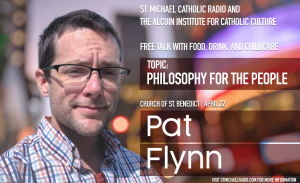Stump the Seminarian – Volume 2
Today’s question, from Ian, is a timely one. It gets to the heart of the Paschal Mystery, and the relationship between the Mass, the Last Supper, and Good Friday:
The Mass is referred to as the “unbloody” re-presenting of the sacrifice on Calvary. But how do we square this description with the fact that the Most Precious Blood is present on the altar? The description seems to imply that we don’t REALLY think the Precious Blood is, in fact, blood. Please help!
The answer to this question should enhance our understanding of just what it is that we’re celebrating this Holy Week.
First, a short answer to the question. “Unbloody” doesn’t mean “bloodless” or without the presence of blood. It means that it’s without the shedding of blood. Common usage clarifies this distinction: if your friend gets badly beaten, you might describe his face as “bloody.” If you turn pale in terror at the sight, he might refer to your face as “bloodless.” Normally, your face is “unbloody,” in the sense that it’s not bloody; but that doesn’t mean that it’s bloodless.
In the Eucharistic Sacrifice, Jesus’ Body and Blood are (a) present, and (b) re-presented to the Father. But that doesn’t require us to re-shed His Blood, or to re-crucify Him. That’s the short answer. But it only makes sense if you understand the important distinction (and connection) between the bloody Sacrifice of Good Friday, and the unbloody Sacrifice of Holy Thursday.
The most direct Old Testament prefigurement of the Sacrifice of Christ is the Passover sacrifice: several Biblical passages link these two together. Broadly speaking, the Passover sacrifice consists of two stages:
- Preparation Day: the lamb’s blood is shed as the lamb is slain.
- The Passover meal: the lamb’s blood is applied (smearing blood on the door posts) and the lamb is eaten.
This is a common theme throughout the Old Testament sacrificial system: by eating the sacrifice, you participated in it, and the sacrifice was applied to you. So Preparation Day and the Passover meal weren’t two separate sacrifices. Rather, they were two distinct parts of a single sacrifice: one half bloody, and the other half unbloody.
All of this points towards Christ in a none-too-subtle way:
- Preparation Day → Good Friday: the Lamb’s Blood is shed as the Lamb is slain. John describes Good Friday as “the day of Preparation of the Passover” (John 19:4).
- The Passover meal → Holy Thursday: the Lamb’s Blood is applied and the Lamb is eaten. Jesus begins the Last Supper by declaring, “I have earnestly desired to eat this Passover with you before I suffer” (Luke 22:15). Significantly, none of the Gospel accounts (or the account given by Paul in 1 Corinthians 10-11) mention the disciples eating lamb at the Passover meal: Christ is the Lamb.
Lest these references be too subtle, John the Baptist refers to Christ as “the Lamb of God who takes away the sins of the world” (John 1:29, 36) and Paul says that “Christ, our Paschal Lamb has been sacrificed” (1 Corinthians 5:7). That last reference is critical, because it shows that the earliest Christian understanding was that the Sacrifice of Christ on the Cross was a Paschal – that is, Passover – Sacrifice. And at the center of the Passover is, of course, the eating of the lamb.
Why are there these two distinct parts to Christ’s sacrifice? After all, the Book of Hebrews say that “we have been sanctified through the offering of the body of Jesus Christ once for all” (Hebrews 10:10). Why do we need anything else?
Perhaps the best way to respond to this is with a question: when were you saved? If you’re a Catholic, you’ll likely point to your baptism. If you’re a Protestant, perhaps you’ll point to a particular moment of conversion, or an instance in which you consciously accepted Jesus as Lord and Savior. But whatever the case, what neither Catholics nor Protestants say is “c. 33 A.D.”
Does that mean that Jesus didn’t save us on Calvary? Does it mean that Jesus had to be re-sacrificed at the moment of our conversion or baptism? No to both. Rather, it means that both Catholics and Protestants realize that the bloody Sacrifice of the Cross, shed once for all in the first century, must be continuously applied in the life of believers. The blood of the Lamb must be smeared on the door-frames of our hearts, and we must eat His Flesh and drink His Blood.
This application is the working of the Holy Spirit through grace. For this reason, the priest at Mass calls down the Holy Spirit in a prayer called the epiclesis, asking Him to turn the bread and wine into the Body and Blood of Christ. But the role of the Third Person of the Trinity isn’t to be sacrificed for us, or to re-sacrifice Christ. Rather, it’s to make the once-for-all Sacrifice present throughout history, by applying Christ’s merits to us.
By the way, Hebrews 9:18-23 shows that there was this connection between the bloody sacrifice and the unbloody application of the sacrifice even in the Old Testament. Instead of the Passover, the example given is Moses’ covering the people with the blood of the sacrifice while saying, “This is the blood of the covenant which God commanded you” (Heb. 9:20). The parallel to Christ’s own words at the Last Supper could hardly be clearer (see 1 Cor. 11:25). So the Eucharistic Sacrifice doesn’t take anything away from Calvary. Rather, it is Calvary, the once-for-all Sacrifice applied throughout history.

